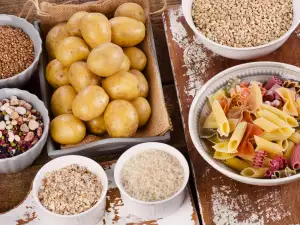Glucose is a water-soluble monosaccharide carbohydrate that has a sweet taste. Glucose owes its sweet taste to 5 hydroxyl groups.
Besides being sweet, the substance is colorless. The process of fermentation is also characteristic for it, the result of which the organic substances are broken down into simpler compounds under the effects of different fermentation enzymes.
History of Glucose
Glucose, before it was known as monosaccharide C6H12O6, was called "grape sugar". It was first mentioned in Moorish writings from the year 1100.
In 1747, German chemist Andreas Marggraf isolated it from sugar beet. However, he labeled the substance "sugar". The term "glucose" first appeared in 1838, given by French chemist Jean Baptiste André Dumas, who used the Greek word "glykos", which means "sweet".
Characteristics of Glucose
When heated, glucose gradually melts and if the temperature is too high it will first caramelize and then may even char.
Spirit fermentation occurs in glucose under the influence of the enzyme zymase. Other enzymes in the fermentation process make it form lactic acid, acetone and others.
In the human body, glucose oxidizes into carbon dioxide and water, which maintain proper body temperature.
Production of Glucose
Glucose can be produced in 2 ways - naturally and industrially. Naturally, the monosaccharide can be synthesized by plants and animals through photosynthesis and the process known as gluconeogenesis.

Industrially, glucose is created using enzymatic hydrolysis by extracting starch from corn, rice, wheat, potatoes and cassava. The process occurs in 2 main phases - liquefying the starch and saccharification.
The 1st stage continues between 1 and 2 hours, the starch liquefying at temperatures of 230°F (110°C). This heat treatment increases the starch's solubility in water but deactivates the enzyme, requiring its addition after each subsequent heating.
During saccharification, the enzyme glucoamylase, derived from the fungi Aspergillus niger at temperatures of 140°F (60°C), is added to the starch. Once this process concludes, glucose forms within 4 days.
Sources of Glucose
In its natural form, glucose is found in many fruits, vegetables, herbs and spices. The highest quantities of it are found in grapes. Glucose is present in strawberries, apricots, cherries, bananas and dried fruits such as prunes, figs.
Among vegetables, glucose can be found in onions, mushrooms, radishes, broccoli, artichokes and spinach.
Some grains are also a good source of glucose - einkorn, buckwheat and corn flour. There are also high quantities of glucose in honey.
Among herbs and spices, it is found in balsamic vinegar, mustard, garlic and licorice.
Benefits of Glucose
Glucose is an important source of energy for the body. It guarantees normal body function during intense physical, emotional or mental stress.
Consumption of it assures our brain's quick reaction in emergency situations. Use of glucose as an energy source in cells happens through the glucose metabolic pathway.
Without sufficient amounts of glucose, the human body cannot function correctly. If the level of glucose drops drastically, thinking processes become muddled but the rhythm of breathing does not change.
When the amount of glucose found in the carbohydrates drops, we begin to lose our ability to control our desire for food, while our appetite increases.
Glucose enters cells with the help of the hormone insulin, which nerve cells break down. Without glucose, brain cells are severely damaged, and this may cause hyperglycaemic coma.
Intake of glucose aids in liver diseases and poisoning by neutralizing the toxins. It is also used for treatments of the cardiovascular and nervous systems and gastrointestinal tract.
Dangers of Glucose
Glucose causes harm to the body only if it is taken in quantities higher than the admissible. Among the negative consequences for the body are stroke, high blood pressure, Alzheimer's and diabetes.

Type I and type II diabetes are caused by excessively high levels of glucose in the blood, that have increased blood sugar levels and from there leading to increased blood pressure levels.
The higher levels of blood sugar constrict blood flow by clogging the arteries, causing a stroke.
The disrupted regulation of glucose in the blood affects memory, destroying brain cells, leading to irreversible Alzheimer's disease.
Intake of Glucose
The recommended daily value is between 40-50 g, with 1 g of glucose containing 4 calories. For people who exercise, it's recommended to take a larger part of this dose after their workout.
Glucose levels in the blood are monitored using the so-called glycemic index which uses a 0 to 100 scale.
















Comments